Safety Evaluation of Multiple Strategies at Stop-Controlled Intersections
Appendix. Additional Installation Details
This appendix provides a description and examples of the general work completed by SCDOT to implement the multiple-strategy improvements at signalized intersections and illustrations of the SCDOT Standard Drawings used in the project. The appendix concludes with a list of general notes related to standard review guidelines, field notes, final plans, and submissions. Most of the following text is excerpted from SCDOT project guidelines. For explanatory purposes, the authors of this report added the text in brackets.
[SCDOT used the following documents during the project:]
- General Signing & Pavement Marking Notes for all Intersections. SCDOT included this document in each work order sent to the contractors. It contains general notes and instructions that pertain to all intersections.
- SCDOT Standard Drawing 625-305-00. This document shows the standard pavement markings for intersections.
- SCDOT Standard Drawing 625-310-00. This document shows the standard pavement markings for turn lanes.
- SCDOT Standard Drawing 625-410-00. This document shows the standard pavement markings for arrows and the word message “Only.”
- Additional Sign Inventory for Replacement. SCDOT decided to replace additional warning and regulatory signs (in addition to the typical) from this table to include signs near the intersection that were considered to have notable safety impacts.
- Unsignalized Intersection Design. This document shows general pavement marking and sign installation information for unsignalized intersections.
- SCDOT Traffic Engineering Guideline 20. SCDOT Traffic Engineering designed this document to provide information on the installation of retroreflective sign post panels.
- SCDOT Guidelines for Advance Placement of Warning Signs. SCDOT revised this document from the Table 2C-4 from the 2009 MUTCD to show suggested placement of advanced warning signs. Proper staking has been one of the biggest issues to date so this document was used to serve as a guideline. 100 feet was added to Condition B (0) to provide additional advance notice needed for the added street name sign.
- Intersection Typicals. These documents are examples of intersection typicals provided to the contractor by SCDOT. They include typicals for a signalized intersection, a four-way stop controlled intersection, a cross-type stop controlled intersection, and a t-type stop controlled intersection. These typicals are revised after field inspection to create a final plan.
- Street Name Sign Typical. This document is an example of the SignCADD layout provided with each intersection typical.
- Placement Dimensions for Stop Ahead. [This document shows dimensions for placement of rumble strips preceding a Stop sign.]
[SCDOT used the following guidance for signing and pavement marking for all intersections.]
Remark all existing stop lines, crosswalks, arrows and word messages unless:
- The roadway has been resurfaced within one calendar year and new thermoplastic markings have been applied.
- Existing markings are uniformly reflective and above ground thickness is ≥ 90 mils.
- Otherwise directed by a district representative.
Individual typicals in work orders may not show all desired markings; therefore, all turn lanes shall be marked to include the pattern of lane arrows and accompanying word message “ONLY” based on the turn lane length, in accordance with Standard Drawing 625-410-00.
As referenced in Standard Drawing 625-410-00 for signalized intersections, combination Straight and Left or Right Turn arrows shall be added on all shared usage lanes where there are two or more through lanes (exclusive or shared). For example, if an approach has an exclusive through lane AND a shared through/right turn lane, the shared lane shall have two through/right turn arrows installed in accordance with Standard Drawing 625-410-00.
Additional pavement marking details for intersections shall be followed in accordance with Standard Drawing 625-305-00 and 625-310-00. Note that all turn bays should be delineated with an extended dashed edgeline as shown in the standard drawings.
If existing lane markings and word messages are in good condition but not compliant with the typical, retain the existing marking scheme and do not install the typical layout.
For fabrication of D series signs, utilize appendix C of the blue MUTCD with 8” capital letters for 4-lane divided roadways and 6” capital letters for all other roadways.
Opposite side signs should be placed adjacent to the existing sign within a 30' tolerance.
If “STOP” pavement marking is used, place 8' letters approximately 10' in advance of stop limit line.
Install retroreflective sign post panels only on signs as indicated on Traffic Engineering Guideline TG-20 that are shown on the original typicals. Additional signs will not require sign post panels.
Do not replace Junction signs with blue border and lettering.
For electric sign mounted flashers, contact the RCE for disconnect of electric power to convert to solar flasher.
Replace all other existing signs within 500' of the intersection that are included in the attached table entitled “Additional Sign Inventory for Replacement.”
Reinstall all pavement markings to match the existing field markings unless otherwise noted, i.e., TWLT markings should not be remarked as double yellow, dashed edge lines should not be installed for single turn lanes, etc.
[The following text is transcribed from SCDOT Standard Drawing 625-305-00. Excerpts of details from the standard drawing are included as figures.]
Application of Markings at Intersections
- Stop lines are to be applied at all signalized intersections.
- At non-signalized intersections, the roadways which must stop are to have stoplines if centerlines are present.
- Where stoplines are used, lane lines and center lines will terminate at the stopline. They do not extend across stoplines nor do they terminate prior to stoplines. Location of stoplines should be determined prior to marking longitudinal lines.
- Lane lines terminating at a stopline should not be less than 10 ft in length, however they may be longer. The last lane line will be 10 to 40 ft long. The following procedure will aid in this determination:
- Mark a spot 50 ft in advance of stopline of each lane line approach.
- If a line is being applied when the spot is crossed, the striper operator permits automatic cut-off and the following 30 gap. When the next line begins, the striper operator will manually override the automatic cut-off and will extend the line to the stopline.
- If a line is not being applied when the spot is crossed, when the next line begins the striper operator will manually override the automatic cut-off and will extend the line to the stopline.
- At all intersections, lane lines will normally be omitted within the intersection area where turning vehicles must maneuver.
[Figure 33 shows a detail of standard markings for intersections.]
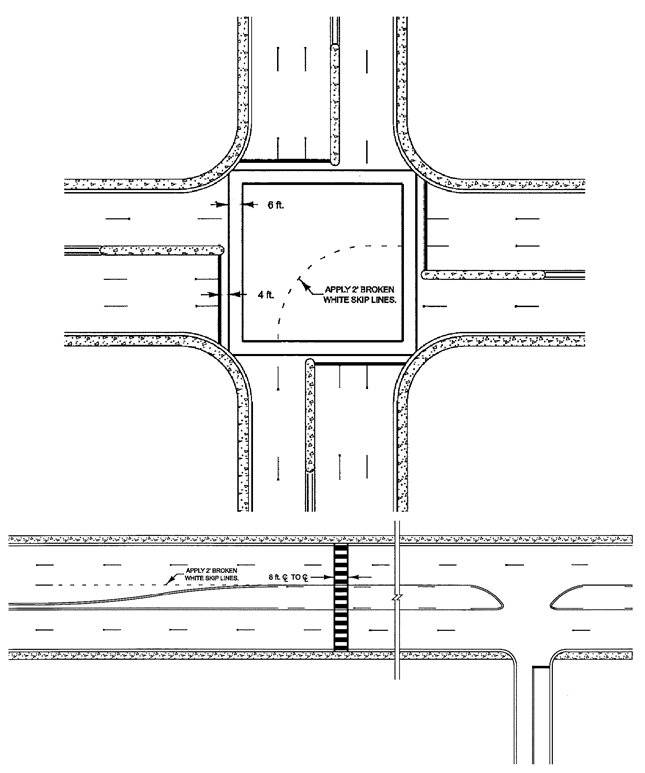
©SCDOT
Figure 33. Illustration. SCDOT Standard Drawing 625-305-00 excerpts for application of markings at intersections.
Arrows and Word Messages
Arrows and word messages are not typical at all turn lanes and will be placed only at locations shown on the plans or where directed by the engineer. In the absence of a marked crosswalk the stopline should be placed at a distance of no less than 4 ft and no more than 30 ft from the where arrows supplement signs to prohibit a movement that would otherwise be legal from that lane, the arrow must be accompanied by the word ‘only.’ All arrows and word messages shall be as indicated on standard drawings 625-410-00.
Additional Guidance through Intersections
[Figure 34 shows guidelines for applying dashed-line pavement markings through intersections.]
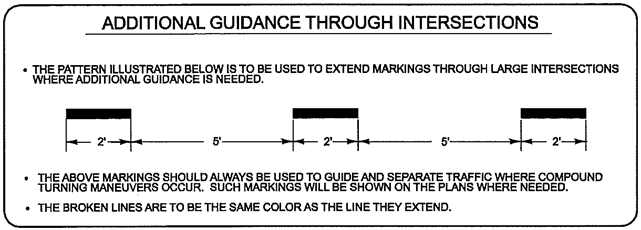
© SCDOT
Figure 34. Illustration. SCDOT Standard Drawing 625-305-00 excerpt for guidance through intersections.
Crosswalks
All crosswalks are to be marked with 8” solid white lines. Crosswalk lines are to be spaced not less than 6 feet apart. [Figure 35 shows standards for an unsignalized school crosswalk.]
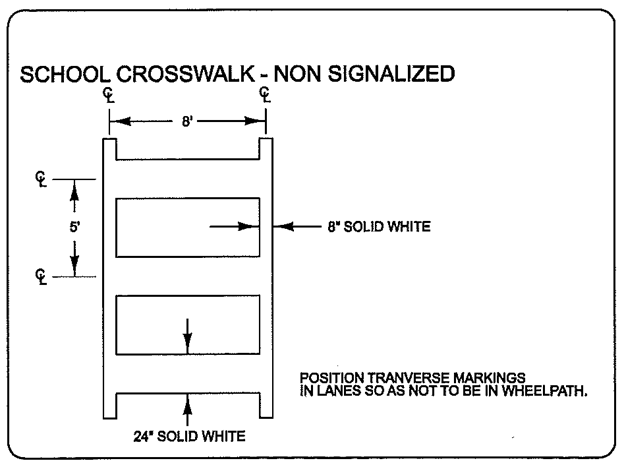
© SCDOT
Figure 35. Illustration. SCDOT Standard Drawing 625-305-00 excerpts for crosswalk markings.
[The following text is transcribed from SCDOT Standard Drawing 625-310-00. Excerpts of details from the standard drawing are included as figures.]
Notes
[The following notes relate to installing typical markings for turn lanes:]
- Length of tapers and chevrons vary. See plan sheets for dimensions.
- Apply arrows, see Standard Drawing number 625-410-00.
- Apply ‘only’ copy, see Standard Drawing number 625-410-00.
- No raised markers are to be applied on chevrons.
- Stoplines shown on mainline are to be applied only at signalized intersections.
[Figure 36 through figure 39 show details for turn lane markings from SCDOT Standard Drawing 625-310-00.]
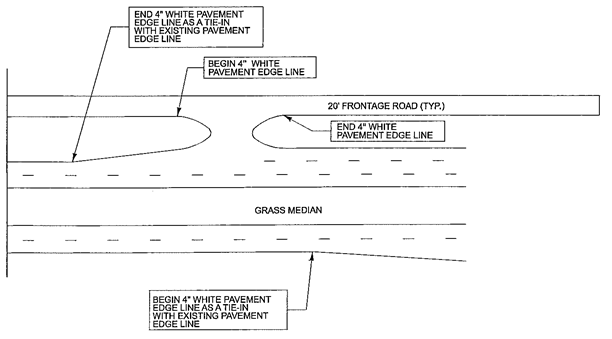
© SCDOT
Figure 36. Illustration. SCDOT Standard Drawing 625-310-00 excerpts for turn lane installations (part 1).
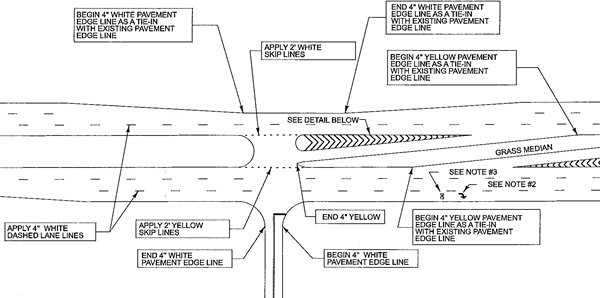
© SCDOT
Figure 37. Illustration. SCDOT Standard Drawing 625-310-00 excerpts for turn lane installations (part 2).
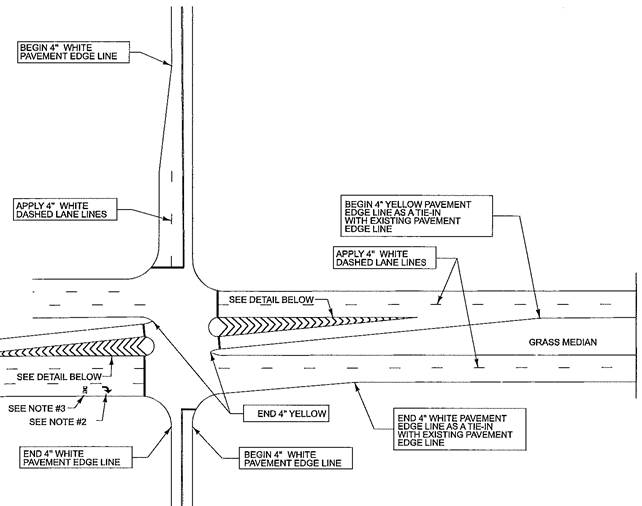
© SCDOT
Figure 38. Illustration. SCDOT Standard Drawing 625-310-00 excerpts for turn lane installations (part 3).
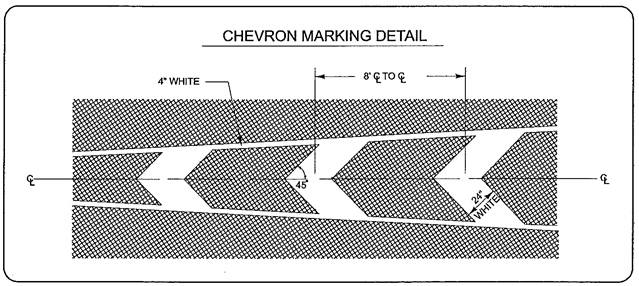
© SCDOT
Figure 39. Illustration. SCDOT Standard Drawing 625-310-00 excerpts for chevron marking details.
[Figure 40 through figure 44 are excerpts of details from SCDOT Standard Drawing 625-410-00.]

© SCDOT
Figure 40. Illustration. SCDOT Standard Drawing 625-410-00 excerpt for straight arrow standard pavement marking.

© SCDOT
Figure 41. Illustration. SCDOT Standard Drawing 625-410-00 excerpt for right or left turn arrow and combination straight and left or right turn arrow standard pavement marking.

© SCDOT
Figure 42. Illustration. SCDOT Standard Drawing 625-410-00 excerpt for right lane drop arrow and left lane drop arrow standard pavement marking.

© SCDOT
Figure 43. Illustration. SCDOT Standard Drawing 625-410-00 excerpt for “ONLY” standard pavement marking.

© SCDOT
Figure 44. Illustration. SCDOT Standard Drawing 625-410-00 excerpt for right or left turn markings application.
[SCDOT replaced additional warning and regulatory signs (in addition to the typical) shown in figure 45 through figure 48, including signs near the intersection that were considered to have notable safety impacts.]

© SCDOT
Figure 45. Illustration. Additional sign inventory for replacement (part 1).

© SCDOT
Figure 46. Illustration. Additional sign inventory for replacement (part 2).

© SCDOT
Figure 47. Illustration. Additional sign inventory for replacement (part 3).

© SCDOT
Figure 48. Illustration. Additional sign inventory for replacement (part 4).
[Table 47 shows the advance placement distance at different posted speed limits or 85th-precentile speeds.]
This chart is intended as a reference with adjustments expected due to field conditions and engineering judgment.
Table 47. Advance placement distance for signal ahead, stop, or intersection warning signs.
Posted or 85th-Percentile
Speed (mi/hr) |
Multilane Approach* (ft) |
Single Lane Approach** (ft) |
20 |
225 |
200 |
25 |
325 |
200 |
30 |
460 |
200 |
35 |
565 |
200 |
40 |
670 |
225 |
45 |
775 |
275 |
50 |
885 |
350 |
55 |
990 |
425 |
60 |
1,100 |
500 |
65 |
1,200 |
575 |
70 |
1,250 |
650 |
75 |
1,350 |
750 |
Note: * These values reflect condition A from table 2C-4 of the 2009 MUTCD and should be used as a reference for designated signs on multilane approaches.
** These values reflect condition B from table 2C-4 of the 2009 MUTCD plus 100 ft due to the chart representing minimum guidelines and the additional advance notice needed due to the supplemental street name signs added to these sign assemblies.
[The following guidelines on the use of retroreflective signpost panels were signed and approved by South Carolina’s Director of Traffic Engineering on June 24, 2008:]
| Number: |
TG-20 |
| Subject: |
Retroreflective Sign Post Panels |
| Background: |
Section 2A.21 of the MUTCD provides guidance on the use of Retroreflective Sign Post Panels. This section states that these panels can be applied to regulatory and warning signs where engineering judgment indicates a need for additional target enhancement during nighttime conditions. Therefore, these panels will generally be applied where crash history indicates a relatively high percentage of nighttime crashes. |
| Guideline: |
The panels shall be constructed of a nonmetallic composite or 3mm aluminum composite material approved by the SCDOT covered with a 3-inch wide type III sheeting. The panel shall be placed for the full length of the support from the sign except that the color for the “Yield” and “Do Not Enter” signs shall be red. If there are two posts supporting the sign, panels should be added to both posts.
To avoid excessive use of the Retroreflective Sign Post Panel, it is suggested that panels only be applied when needed to the regulatory signs below:
- Red Regulatory Signs. Stop, Yield, Do Not Enter, and Wrong Way signs—Red Panels.
- Horizontal Alignment Signs. Chevrons, Curve, Turn, and Large Arrow signs—Yellow Panels.
- Advance Traffic Control Signs. Stop Ahead, Yield Ahead, and Signal Ahead signs—Yellow Panels.
- Intersection Warning Signs. Cross Road, Side Road, and Two-Direction Large Arrow signs—Yellow Panels.
- Pedestrian Signs and School Area Signs. W11-2 and S1 Series—Fluorescent Yellow Green Panels.
|
[Figure 49 and figure 50 show standards for pavement marking and rumble strip placement at unsignalized intersections.]

© SCDOT
Figure 49. Illustration. SCDOT nonsignalized intersection design for pavement marking and sign installations.
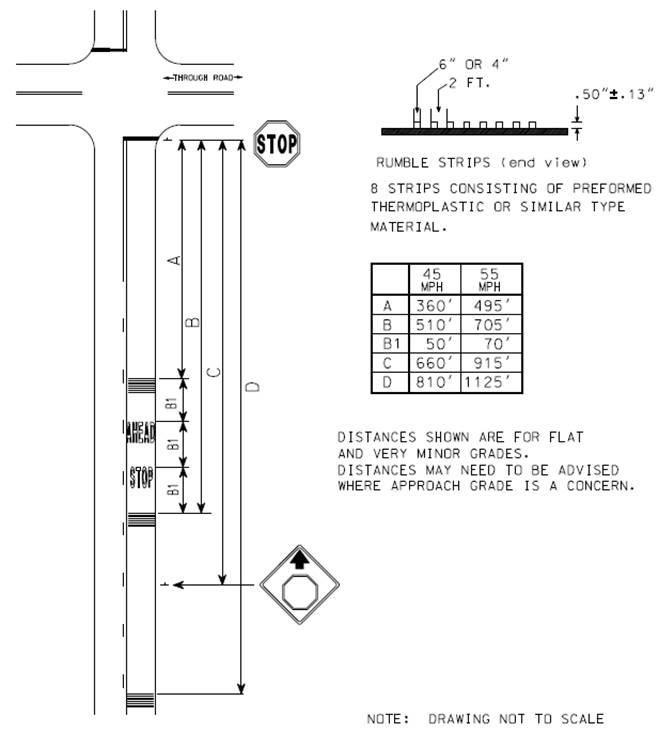
© SCDOT
Figure 50. Illustration. SCDOT traffic engineering rumble strip typical.
[Figure 51 through figure 54 are examples of intersection typicals that SCDOT provided to the contractor, including a signalized intersection, a four-way stop-controlled intersection, a cross-type controlled intersection, and a t-type strop-controlled intersection.]
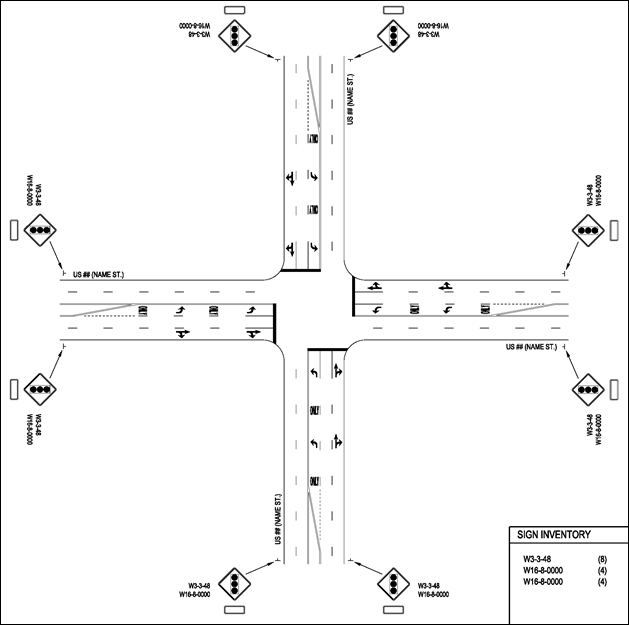
© SCDOT
Figure 51. Illustration. SCDOT typical for a signalized intersection.
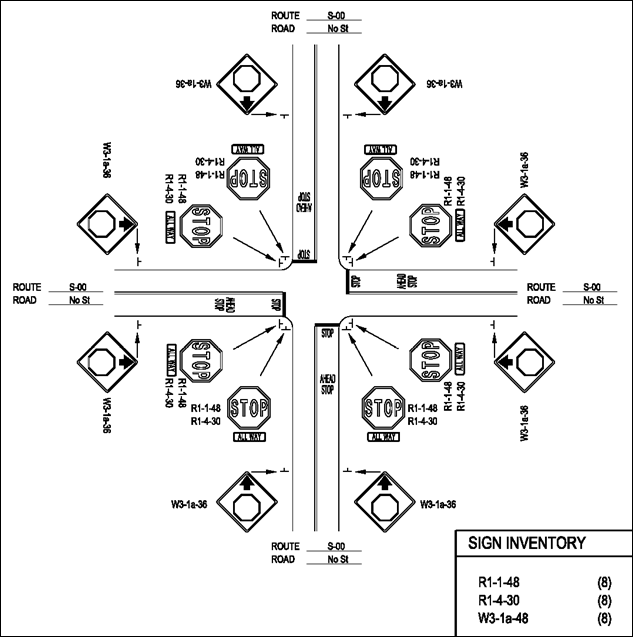
© SCDOT
Figure 52. Illustration. SCDOT typical for a four-way stop controlled intersection.
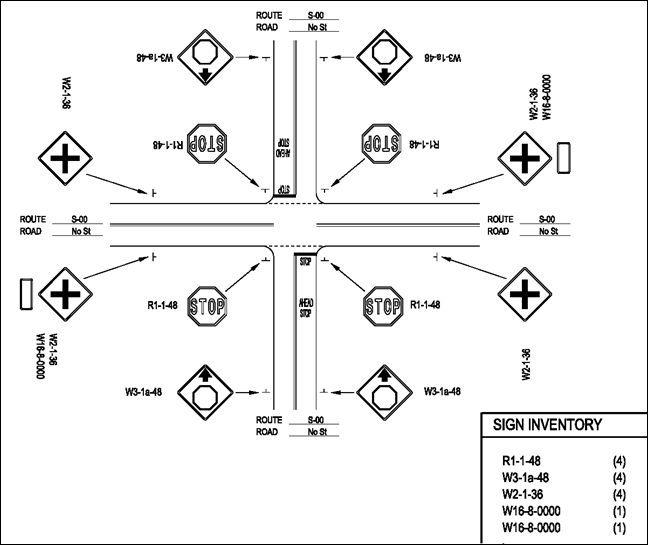
© SCDOT
Figure 53. Illustration. SCDOT typical for a cross-type stop controlled intersection.
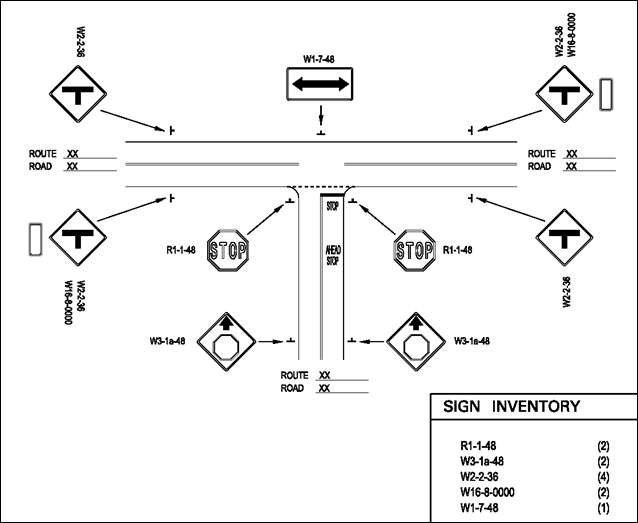
© SCDOT
Figure 54. Illustration. SCDOT typical for a t-type stop controlled intersection.
[Figure 55 shows a street name sign typical layout.]
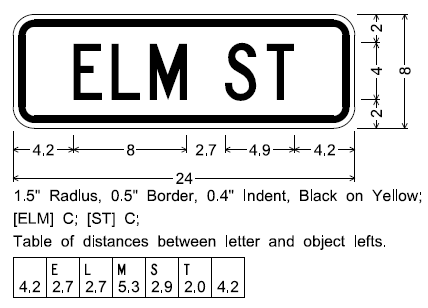
© SCDOT
Figure 55. Illustration. SCDOT street name sign typical.
Standard Review Guidelines(20)
[The following is an excerpt from an internal SCDOT document containing standard review guidelines for reviewing installations of the treatments in this project.]
General Notes
- Speed limit signs are not to be replaced as part of this project.
- Additional Advisory Speed plaques (such as speed plaques on “Trucks Entering Hwy” sign, etc.) will not be addressed as a part of this project.
- Do not list info for retroreflective sign post panels on the plans.
- Left Turn arrow Pavement Markings shall be installed in TWLTL’s.
- Show all signs as proposed; do not shade anything to represent existing conditions.
- Any non-standard intersections, i.e., free flow interchanges or roundabouts should be sent to SCDOT Safety Office for verification and instruction.
- No Pavement Markings or signs shall be applied to routes that are not state maintained.
- All Illumination shall be upgraded to LED.
- Yield conditions shall receive yield line and skip line pavement markings.
- Place note “retain existing” for all non-MUTCD signs.
- A photo of the current street name signs in the field trumps all spelling of the street name.
- No signs should be placed in paved radii.
- Limit sign placement for dead ends, short routes, grid systems, etc.
- Engineering judgment should be used when placing all warning signs.
- Under urban grid conditions cross road warning signs (or signal ahead signs) should not be placed.
- Signs should not be placed near driveways (where it would obstruct sight distance) or in citizen’s front yard.
- Signs should not be placed when an object would obscure their view (i.e., a large tree, shrubs, bridge columns, etc.).
- Use caution when placing signs in historic districts.
- Use caution when placing signs on interchange entrance and exit ramps.
- Guidelines for placing opposite side intersections (or signal) warning signs.
- Do not place on roadways with more than three-lanes (three-lanes meaning two through lanes and a paved median).
- On four-lane divided highways signs should be placed in the median.
- We will not be making upgrades to existing ramps at crosswalks.
Non-Signalized Locations
- Include estimated quantities for crosswalk, stop lines, yield lines, and skip lines on final sheet for non-signalized locations.
- Left turn Arrows and ONLY’s:
- Less than 250' – arrow ONLY arrow.
- 250' or more – arrow ONLY arrow ONLY.
- D-Signs – Make a note of the size of the letters on the signs:
- Only need to note of existing 8" letters on 4-lane divided.
- Do not show junction signs unless they are attached to a D-sign that is being moved or replaced.
- Skip lines and yield lines must be shown at all yields.
- Overhead Flashers at a stop intersection should be treated as a signalized location and have plans made for both pavement markings/signs and signals. All flashers will be replaced with LED casings and modules. NOTE: this does not include pole-mounted flashers on a Stop sign, Stop Ahead sign or intersection warning sign.
- No NEW Flashers will be installed on Stop controlled intersections.
- All Signal Ahead, Stop Ahead, Yield and Stop signs shall be 48”. Stop and Yield signs in the median or in exclusive turn lanes can be 30”. Use engineering judgment to determine.
- Intersection warning signs shall be 36”.
- Guidelines for placing street name signs on intersection warning signs:
- On all undivided roadways street name signs should be placed on only the right side intersection warning sign (no opposite side sign placement).
- On four-lane divided highways street name signs should be placed on both the right side and opposite side intersection warning signs (if they are both used).
- Word messages (such as “STOP” and “STOP AHEAD”) should be used sparingly. Only when currently in the field or engineering judgment warrants their placement (i.e., no warning signs or opposite side signs can be placed).
Signalized Locations
- All signal ahead signs must have street names.
- Yield and stop lines must be behind crosswalk. Indicate on plans that the stop lines/yield lines need to be eradicated and new ones installed to accommodate the crosswalk.
- Show piano lines in crosswalk only if they currently exist.
- Ramps will be counted as 2 if crosswalks don’t connect at the corner and 1 if they do.
- Left Turn Yield on Green (ball) sign - only installed when protected/permissive left turn (5-signal face, dog-house style head).
- There should be one 3-signal face head located in the center of each thru lane, as a minimum. A 5-signal face PT/PM head counts as one thru lane signal.
- Skip lines and yield lines must be shown at all yields.
- No NEW flashers will be installed at signalized locations.
- At intersections where Ped Heads are currently installed, if the “Walk” symbol appears automatically, then no Push Buttons are required.
- All Ped Heads shall be Countdown.
- If Ped Heads are present, propose crosswalks.
- If Push Buttons are present a crosswalk is not required.
- If a crosswalk is required, show ramps. If ramps cannot be installed mark on field notes why (i.e., catch basin).
- If ped BUTTONS are present (or proposed) = cross walks are not required.
- If ped HEADS are present (or proposed) = cross walks are required.
- If cross walks are present (or proposed) = ped heads should be present.
- Quantities for pedestrian equipment will be estimated based on the number of NEW pedestrian equipment installed.
- Number of signal heads: With permitted/protected left - 1 signal head per thru lane (5 signal face, dog-house style counts as one). With protected only left - 4 signal face, red arrows for left lane + 1 signal face per thru lane.
Field Notes
- Location information (Street names, county, etc.)
- Indicate reasons for not following regular guidelines so we know that it was not just overlooked… ped treatments, crosswalk, ramps, signs, etc.
- Any information or recommendations that may be helpful that you happen to notice while you are in the field.
- If “Signal Ahead” or “Stop Ahead” signs are determined not to be necessary, put note on field sheet as to why.
- On field notes, make mention of conflicting signs. For example, a Stop controlled intersection located between a signalized intersection and its coordinating “Signal Ahead” sign. Locations of the proposed intersection warning signs should be discussed with SCDOT.
- On field notes, note if JCT signs are black or blue.
- Note on field sheets any landscaped areas where proposed signs are to be located as well as any historic districts.
- Note on field sheets if medians or islands are pavement markings or raised. If raised, note if it is earthen or concrete.
- Street name signs on Mast Arms and Span Wire to be noted in field notes but not to be replaced.
Final Plans
- Name the intersections as they are in the list given by SCDOT.
- Consultant Company logos.
- Note NOT TO SCALE.
- Speeds from each approach.
- North arrow.
- Any changes that are made to a signalized location must be called out with an arrow pointing and a note indicating a change, i.e., Install new ped treatments (with arrows to new ped treatments only), Install NEW near-side head (with arrows to new near-side heads only), Install NEW ramp (…), Install NEW overhead signs (…), Install NEW red arrow LED head (…), etc.).
- These changes may or may not require a new PE’d plan. At a minimum, they will require an update to the signal plan if one exists. Please supply a list of signalized locations that will require a new plan to be drawn and which additions there were to the plan. (See checklist for submitting packets.)
- Example list:
- US1 @ SC12 – nearside head, ped treatments.
- US1 @ S-35 – ped treatments, ramps.
- US1 @ S-1298 – additional thru lane head, ramps.
- Small maps are not necessary on Final plans (per example plan set for LCSI letting.pdf).
- Right of way does not need to be shown on plans.
- Signal Equipment box is not necessary on the Final plans.
Submissions
- Round 2 and 3 signals and stops can be submitted at the same time to cover the area all at once.
- Submit packets of approximately 50 locations at a time.
- If at all possible, do not split up a single county into two different submittals; it’s best to have all locations in each county together.
- Submittals should include two packets:
- Signal group – this packet will go to the signal group for review and contain all necessary documents spelled out below.
- Safety group – this packet will go to the safety group for review and contain all necessary documents spelled out below.
Checklist for Submitting Packets
Initial Signal Group:
_____ Final plan – electronic version printout, may have pavement markings and signs on them
_____ Field notes plan – can be hand drawn plan or notes handwritten on electronic print, make notes for all decisions that are not following the standard recommendations (i.e., no signal ahead sign because signal nearby, no sidewalk ramp because gutter under curb, no double up on signal ahead because of somebody’s beautiful garden, etc.)
_____ Quantities form – can be hand written from field as long as legible, include color of signal head/ped head casing, whether there are mast arms or not
_____ Electronic photos or ftp
_____ Electronic plans on disk or ftp
_____ Electronic list of locations needing updated signal plan
Final Signal Group Construction Packet:
_____ Coversheet
_____ Quantity sheets
_____ Drawing for each location
_____ Construction specifications with specific location information for the district
Safety Group:
_____ Electronic Documents (submitted on CD is fine) - Microstation file for each location, PDF of field notes and quantities sheet, PDF of final plan and any photos taken during the site review
_____ Cover sheet – this should include a list of all locations included in the packet (along with their signalized or stop controlled status) and all locations omitted from the packet along with the reason for omission (current project, interchange, etc.). Please also note the locations where overhead flashers (mounted on span wire or mast arms) are present. These will need to be included in both the signalized and safety packets.
_____ For signalized locations: include a hard copy of the final signing and marking plan (without signal information), a copy of the field notes and a copy of the quantities sheet.
_____ For stop controlled locations: include a hard copy of the final signing and marking plan, a copy of the field notes and a copy of the quantities sheet.
_____ For stop controlled locations with overhead flashers: include a hard copy of the final signing and marking plan (include flasher information on both the safety and signal copies for overhead flashers only), a copy of the field notes and a copy of the quantities sheet.











